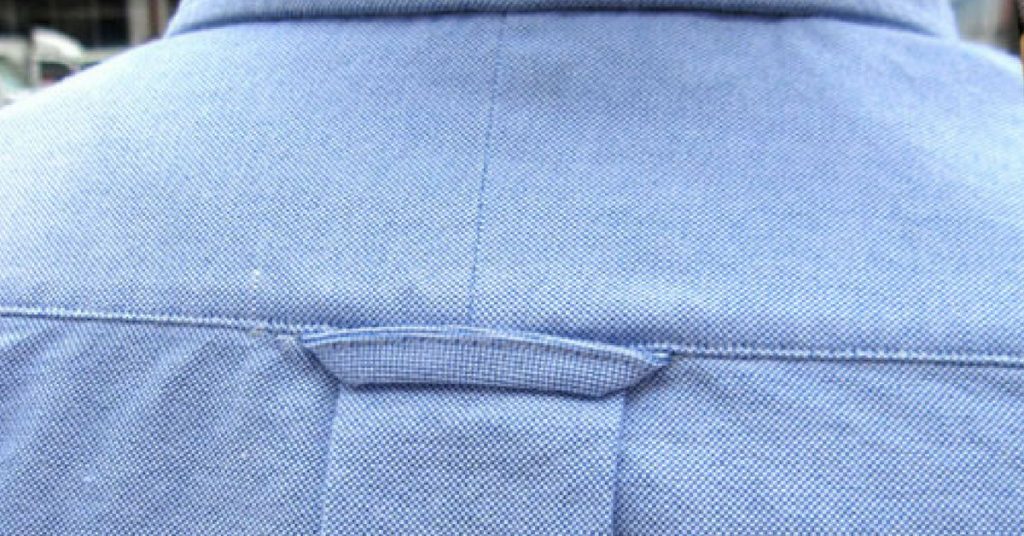The Loopy Way to Show One’s Affection

Pictured above is the back of a men’s dress shirt — or, at least, the top part of it (but below the collar). You’ll notice that there’s a little piece of fabric just under the seam where the shoulder section meets the rest of the shirt. And because you’ve almost certainly seen a men’s dress shirt before, you already know that piece of fabric forms a loop. The loop is there, unsurprisingly, to help you hand your shirt up. But for a brief moment in the 1960s or so, it served another purpose — to help you find a girlfriend.
Or, perhaps more accurately, to help your girlfriend keep you from finding a new one.
Let’s start with the “hanging up your shirt” part first, though. Dress shirts wrinkle easily so you can’t just kind of toss them on a shelf, like you would, say, a t-shirt. Instead, one typically puts the shirt on a hanger hangs it up that way. But that requires a bar or wall hook (or something similar) to hang the hanger on. That’s typically not a problem — when we build houses and apartments, we design them for rooms called closets, which are specifically created with this need in mind. But for those who served in the Navy, dress shirts were required but closets weren’t provided. That latter part makes sense: space is tight on ships. According to Southern Living, that may have been the origin of these back-of-shirt loops: “sailors didn’t have closets to hang their shirts, so their clothing was outfitted with loops so that they could simply slide onto a hook on the wall.”
The convenience and ease of the loops spread beyond sailors at some point in the 1960s. According to Mental Floss, “clothing manufacturer GANT added what became known as a locker loop to their dress shirts so their customers—frequently Ivy League college students—could hang the shirts in their lockers without them getting wrinkled.” Where the Ivy League went, many other schools and students followed, and before the decade was out, it was harder to find a shirt without a “locker loop” than one with one. But, of course, very few people actually used the loop. Unless you’re George Constanza, there just aren’t that many places where you take your shirt off outside of your home.
Perhaps seeing the relative uselessness of the locker loop, a new trend emerged — not around garment care, but around dating and relationships. Young men, as the Today Show explains, “would remove the loop to show they were taken.” Potential new girlfriends would have to wait until the boy broke up with his current girlfriend and, of course, bought himself some new shirts.
It seems like a sweet and harmless way for young men to show their fidelity to their girlfriends, but quickly, things got out of control. While some men gladly gave over the locker loops to their sweethearts, those who were not yet in relationships had a sign on their back signaling that they were single. And some of their love interests saw this as an opportunity to lay claim to their potential future boyfriends. The Today Show continues: “[some] young ladies would yank loops off of shirts that boys they took a liking to were wearing, according to a representative at [shirt manufacturer] GANT.” The men who were the targets of loop theft, to coin a term, were now in a lose-lose situation. As the Today Show explained, “tightly stitched loops would often tear a large strip from the back of the shirt and render it unwearable.” And if the loop came off cleanly, the boy now appeared to be in a relationship, even though he wasn’t.
Destroyed shirts, crumbled relationships, and probably some light assault and batter. It’s not hard to see why the practice of giving your love a little piece of fabric faded. But before the fad went away, at least one shirt retailer tried to capitalize on the trend. In the fall of 1965, as seen on the right here, a North Carolina store offered men a great deal — buy a shirt from them, and they’ll give you some free locker loops to hand out to the women in your life. There was no limit to the number of loops one could request — the ad promised “enough locker loops to keep a harem happy” — but they did ask you to only request a reasonable amount: “as many as you need, but please, no bragging.”
Bonus fact: If you watch a movie set in the Old West or Prohibition, you may notice that some of the men are wearing thin armbands on their sleeves. (Here’s a picture of a barbershop quartet at Walt Disney World, and you’ll see the bands on each of their arms.) Those are called sleeve garters, and they’re a throwback from when sleeves came in one very-long size. As Beth Dincuff, a professor of fashion history explained to Fashionista, “back in the 19th century, men’s shirts didn’t have buttons at the sleeves, so they were a little looser. Men would wear sleeve garters to pull them up and make it a little shorter, especially for work — whether they were bartenders, cowboys, musicians,” etc. The garter was a cheaper alternative to a tailor, and also, offered a more flexible solution — if you needed to adjust your shirt sleeve length, all you needed to do was adjust the garter.
From the Archives: Why Women’s Shirts Button Backward: Men’s dress shirts button one way, women’s button the other way. Here’s why.
